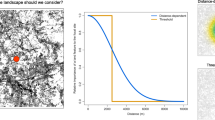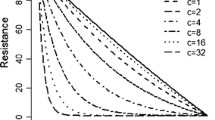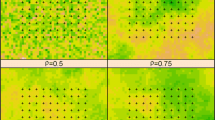Abstract
Species range shifts and the spread of diseases are both likely to be driven by extreme movements, but are difficult to statistically model due to their rarity. We propose a statistical approach for characterizing movement kernels that incorporate landscape covariates as well as the potential for heavy-tailed distributions. We used a spliced distribution for distance travelled paired with a resource selection function to model movements biased toward preferred habitats. As an example, we used data from 704 annual elk movements around the Greater Yellowstone Ecosystem from 2001 to 2015. Yearly elk movements were both heavy-tailed and biased away from high elevations during the winter months. We then used a simulation to illustrate how these habitat effects may alter the rate of disease spread using our estimated movement kernel relative to a more traditional approach that does not include landscape covariates. Supplementary materials accompanying this paper appear online.





Similar content being viewed by others
References
Andrieu, C., and Roberts, G. O. (2009), “The pseudo-marginal approach for efficient Monte Carlo computations,” Ann. Statist., 37(2), 697–725. https://doi.org/10.1214/07-AOS574
Avgar, T., Potts, J. R., Lewis, M. A., and Boyce, M. S. (2016), “Integrated step selection analysis: bridging the gap between resource selection and animal movement,” Methods in Ecology and Evolution, 7(5), 619–630. http://onlinelibrary.wiley.com/doi/10.1111/2041-210X.12528/abstract
Bacaër, N, N. (1838), “Verhulst and the logistic equation (1838),” in A Short History of Mathematical Population Dynamics, London: Springer London, pp. 35–39. http://webpages.fc.ul.pt/~mcgomes/aulas/dinpop/Mod13/Verhulst.pdf
Beaumont, M. A. (2003), “Estimation of Population Growth or Decline in Genetically Monitored Populations,” Genetics, 164(3), 1139–1160. http://www.genetics.org/content/164/3/1139
Behrens, C. N., Lopes, H. F., and Gamerman, D. (2004), “Bayesian analysis of extreme events with threshold estimation,” Statistical Modelling, 4(3), 227–244. https://doi.org/10.1191/1471082X04st075oa
Clark, J. S. (1998), “Why Trees Migrate So Fast: Confronting Theory with Dispersal Biology and the Paleorecord,” The American Naturalist, 152(2), 204–224 http://www.jstor.org/stable/10.1086/286162
Clark, J. S., Lewis, M., McLachlan, J. S., and HilleRisLambers, J. (2003), “Estimating Population Spread: What Can We Forecast and How Well?,” Ecology, 84(8), 1979–1988. http://onlinelibrary.wiley.com/doi/10.1890/01-0618/abstract
Clark, J. S., Silman, M., Kern, R., Macklin, E., and HilleRisLambers, J. (1999), “Seed Dispersal Near and Far: Patterns Across Temperate and Tropical Forests,” Ecology, 80(5), 1475–1494. http://onlinelibrary.wiley.com/doi/10.1890/0012-9658(1999)080[1475:SDNAFP]2.0.CO;2/abstract
Coulon, A., Morellet, N., Goulard, M., Cargnelutti, B., Angibault, J.-M., and Hewison, A. (2008), “Inferring the effects of landscape structure on roe deer (Capreolus capreolus) movements using a step selection function,” Landscape Ecology, 23(5), 603–614. https://link.springer.com/article/10.1007/s10980-008-9220-0
Cross, P. C., Maichak, E. J., Rogerson, J. D., Irvine, K. M., Jones, J. D., Heisey, D. M., Edwards, W. H., and Scurlock, B. M. (2015), “Estimating the phenology of elk brucellosis transmission with hierarchical models of cause-specific and baseline hazards,” Journal of Wildlife Management, 79(5), 739–748. https://wildlife.onlinelibrary.wiley.com/doi/abs/10.1002/jwmg.883
Davison, A. C., and Smith, R. L. (1990), “Models for Exceedances over High Thresholds,” Journal of the Royal Statistical Society. Series B (Methodological), 52(3), 393–442. http://www.jstor.org/stable/2345667
Forester, J. D., Im, H. K., and Rathouz, P. J. (2009), “Accounting for animal movement in estimation of resource selection functions: sampling and data analysis,” Ecology, 90(12), 3554–3565. http://onlinelibrary.wiley.com/doi/10.1890/08-0874.1/abstract
Garcí-a, C., and Borda-de Água, L. (2017), “Extended dispersal kernels in a changing world: insights from statistics of extremes,” Journal of Ecology, 105(1), 63–74. https://doi.org/10.1111/1365-2745.12685
Gneiting, T., and Raftery, A. E. (2007), “Strictly proper scoring rules, prediction, and estimation,” J. Amer. Statist. Assoc., 102(477), 359–378. https://doi.org/10.1198/016214506000001437
Hanks, E. M., Hooten, M. B., and Alldredge, M. W. (2015), “Continuous-time discrete-space models for animal movement,” Ann. Appl. Stat., 9(1), 145–165. https://doi.org/10.1214/14-AOAS803
Haran, M., and Hughes, J. (2016), batchmeans: Consistent Batch Means Estimation of Monte Carlo Standard Errors, Denver, CO. R package version 1.0-3.
Hijmans, R. J. (2016), raster: Geographic Data Analysis and Modeling. R package version 2.5-8. https://CRAN.R-project.org/package=raster
Hooten, M. B., Hanks, E. M., Johnson, D. S., and Alldredge, M. W. (2013), “Reconciling resource utilization and resource selection functions,” Journal of Animal Ecology, 82(6), 1146–1154. http://pubs.er.usgs.gov/publication/70192618
Hooten, M. B., Johnson, D. S., Hanks, E. M., and Lowry, J. H. (2010), “Agent-Based Inference for Animal Movement and Selection,” Journal of Agricultural, Biological and Environmental Statistics, 15(4), 523–538. https://doi.org/10.1007/s13253-010-0038-2
Hooten, M. B., Johnson, D. S., McClintock, B. T., and Morales, J. M. (2017), Animal movement: Statistical models for telemetry data CRC Press. http://pubs.er.usgs.gov/publication/70192618
Hu, Y. (2013), Extreme Value Mixture Modelling with Simulation Study and Applications in Finance and Insurance, Master’s thesis, University of Canterbury, New Zealand. http://www.math.canterbury.ac.nz/~c.scarrott/evmix/thesis.pdf
Johnson, D. S., Thomas, D. L., Ver Hoef, J. M., and Christ, A. (2008) , “A General Framework for the Analysis of Animal Resource Selection from Telemetry Data,” Biometrics, 64(3), 968–976. http://onlinelibrary.wiley.com/doi/10.1111/j.1541-0420.2007.00943.x/abstract
Kamath, P. L., Foster, J. T., Drees, K. P., Luikart, G., Quance, C., Anderson, N. J., Clarke, P. R., Cole, E. K., Drew, M. L., Edwards, W. H., Rhyan, J. C., Treanor, J. J., Wallen, R. L., White, P. J., Robbe-Austerman, S., and Cross, P. C. (2016), “Genomics reveals historic and contemporary transmission dynamics of a bacterial disease among wildlife and livestock,” Nature Communications, 7, 11448. https://doi.org/10.1038/ncomms11448
Kot, M., Lewis, M. A., and van den Driessche, P. (1996), “Dispersal Data and the Spread of Invading Organisms,” Ecology, 77(7), 2027–2042. https://www.jstor.org/stable/2265698
Lindström, T., Håkansson, N., and Wennergren, U. (2011), The shape of the spatial kernel and its implications for biological invasions in patchy environments,, in Proceedings of the Royal Society B: Biological Sciences, Vol. 278, pp. 1564–1571. http://rspb.royalsocietypublishing.org/content/early/2010/11/01/rspb.2010.1902
MacDonald, A., Scarrott, C., Lee, D., Darlow, B., Reale, M., and Russell, G. (2011), “A flexible extreme value mixture model,” Computational Statistics & Data Analysis, 55(6), 2137–2157. http://www.sciencedirect.com/science/article/pii/S0167947311000077
Marzluff, J. M., Millspaugh, J. J., Hurvitz, P., and Handcock, M. S. (2004), “Relating Resources to a Probabilistic Measure of Space Use: Forest Fragments and Steller’s Jays,” Ecology, 85(5), 1411–1427. https://esajournals.onlinelibrary.wiley.com/doi/abs/10.1890/03-0114
McClintock, B. T., Johnson, D. S., Hooten, M. B., Ver Hoef, J. M., and Morales, J. M. (2014), “When to be discrete: the importance of time formulation in understanding animal movement,” Movement Ecology, 2(1), 21. https://doi.org/10.1186/s40462-014-0021-6
McClintock, B. T., King, R., Thomas, L., Matthiopoulos, J., McConnell, B. J., and Morales, J. M. (2012), “A general discrete-time modeling framework for animal movement using multistate random walks,” Ecological Monographs, 82(3), 335–349. https://esajournals.onlinelibrary.wiley.com/doi/abs/10.1890/11-0326.1
Meagher, M., and Meyer, M. E. (1994), “On the Origin of Brucellosis in Bison of Yellowstone National Park: A Review,” Conservation Biology, 8(3), 645–653. https://doi.org/10.1046/j.1523-1739.1994.08030645.x
Morales, J. M. (2002), “Behavior at Habitat Boundaries Can Produce Leptokurtic Movement Distributions,” The American Naturalist, 160(4), 531–538. http://www.jstor.org/stable/10.1086/342076
Morales, J. M., Haydon, D. T., Frair, J., Holsinger, K. E., and Fryxell, J. M. (2004), “Extracting more out of relocation data: Building movement models as mixtures of random walks,” Ecology, 85(9), 2436–2445. https://esajournals.onlinelibrary.wiley.com/doi/abs/10.1890/03-0269
National Academies of Sciences, Engineering, and Medicine (2017), Revisiting Brucellosis in the Greater Yellowstone Area, Washington, DC: The National Academies Press. https://www.nap.edu/catalog/24750/revisiting-brucellosis-in-the-greater-yellowstone-area
Naveau, P., Huser, R., Ribereau, P., and Hannart, A. (2016), “Modeling jointly low, moderate, and heavy rainfall intensities without a threshold selection,” Water Resources Research, 52(4), 2753–2769. https://doi.org/10.1002/2015WR018552
Park, T., and Casella, G. (2008), “The Bayesian Lasso,” Journal of the American Statistical Association, 103(482), 681–686. https://doi.org/10.1198/016214508000000337
R Core Team (2016), R: A Language and Environment for Statistical Computing, R Foundation for Statistical Computing, Vienna, Austria. https://www.R-project.org/
Roberts, G. O., and Rosenthal, J. S. (2009), “Examples of Adaptive MCMC,” Journal of Computational and Graphical Statistics, 18(2), 349–367. https://doi.org/10.1198/jcgs.2009.06134
Scarrott, C. (2015), “Univariate Extreme Value Mixture Modeling,” in Extreme Value Modeling and Risk Analysis, eds. D. K. Dey, and J. Yan, Boca Raton, Florida: Chapman and Hall/CRC, pp. 41–67. https://doi.org/10.1201/b19721-4
Scarrott, C. J., and Hu, Y. (2017), “evmix 0.2.7: Extreme Value Mixture Modelling, Threshold Estimation and Boundary Corrected Kernel Density Estimation,”. Available on CRAN. http://www.math.canterbury.ac.nz/~c.scarrott/evmix
Scarrott, C. J., and MacDonald, A. (2012), “A review of extreme value threshold estimation and uncertainty quantification,” REVSTAT - Statistical Journal, 10(1), 33–60.
Spiegelhalter, D. J., Best, N. G., Carlin, B. P., and Van Der Linde, A. (2002), “Bayesian measures of model complexity and fit,” Journal of the Royal Statistical Society: Series B (Statistical Methodology), 64(4), 583–639. http://onlinelibrary.wiley.com/doi/10.1111/1467-9868.00353/abstract
Urban, M. C., Phillips, B. L., Skelly, D. K., and Shine, R. (2008), “A Toad More Traveled: The Heterogeneous Invasion Dynamics of Cane Toads in Australia.,” The American Naturalist, 171(3), E134–E148. PMID: 18271722. https://doi.org/10.1086/527494
Acknowledgements
We gratefully acknowledge financial support from DOE DE-AC02-05CH11231, USGS G16AC00055, NSF EEID 1414296, NIH GM116927-01, NSF MRI-1626251, NSF DMS-1752280 and NSF DEB-1245373. Computations for this research were performed on the Pennsylvania State University’s Institute for CyberScience Advanced CyberInfrastructure (ICS-ACI). This content is solely the responsibility of the authors and does not necessarily represent the views of the Institute for CyberScience. We thank Montana, Fish, Wildlife and Parks, Idaho Department of Fish and Game, Wyoming Game and Fish Department, Yellowstone and Grand Teton National Parks, US Fish and Wildlife Service, and Wildlife Conservation Society for providing elk location data. Any mention of trade, product or firm names is for descriptive purposes only and does not imply endorsement by the US Government.
Author information
Authors and Affiliations
Corresponding author
Electronic supplementary material
Below is the link to the electronic supplementary material.
Appendices
Appendix A: Treatment of Missing Values
We encountered missing values in certain landcover rasters. Aggregating the raster reduced the number of missing values significantly. We observed that missing values were in landscape cells that fell on the boundaries of certain rasters (this is clearly seen in Fig. 2). We also noted that landscape cells with missing values were far away from the region where we observed elk movements. We used a \(27 \times 27\) grid to interpolate the value of a missing landscape cell. We weighted the grid giving landscape cells closer to the missing landscape cell higher weights than those further away.
Appendix B: Simulation Study to Test Bias in Estimation
In order to check if there is a systematic bias induced by approximating the normalizing constant using a Monte Carlo approximation, we conducted a simulation study with a single covariate (Elevation) and a gamma distance kernel. We set the true parameter values to \((\beta , k, \theta )=(-1, 0.8615017, 12.63035)\). We simulated 1000 datasets each with 200 yearly movements where the start locations for the 200 movements were chosen randomly from the 704 movements in the dataset. We simulated from our model using importance sampling. We first simulated many end locations \(\mathbf {e}_i\) for each start location by simulating bearings and distances from the distance kernel. We then sampled a single end location drawn randomly from the simulated end locations, with probabilities proportional to \(\mathrm{e}^{x(\mathbf {e}_i) \beta }\). After simulating 200 yearly movements in this way, we estimated model parameters using the Bayesian method given in Sect. 3. We used 2500 Monte Carlo samples to approximate the normalizing constant. We fit the model to the simulated data running the MCMC sampler for 30,000 iterations and removed the first 5000 runs as burn in. We obtained the posterior mode for each parameter from each dataset and plotted their densities in Fig. 6. The true values are given using a solid vertical line. It is clearly evident from Fig. 6 that there is very little systematic bias induced when using the proposed estimation procedure.
The distributions of posterior modes for the parameters a\(\beta \), b\(\log (k)\) and c\(\log (\theta )\) for models with a fixed covariate elevation and a gamma distance kernel. The true values of the parameters are \(\beta =-1\), \(\log (k)=-0.1490782\) and \(\log (\theta )=2.536103\). There is no evidence of an estimation bias.
We also simulated 3 datasets using gamma and spliced distance kernels. The true parameters used were \((\beta , k, \theta )=(-1, 0.8615017, 12.63035)\) and \(\xi =0.2\) with \(u =10\) and \(\phi _u=0.3\). The start locations were taken to be those of the actual data. We simulated the end locations similarly to that given above using the relevant distance kernel. We used 5000 Monte Carlo samples in the likelihood estimation. The results are given in Fig. 7. We found that all the true parameters were captured well giving us the assurance that the estimation procedure does well for models with spliced kernels too.
The posterior distributions of the parameters a\(\beta \), b\(\log (k)\), c\(\log (\theta )\) and d\(\xi \) for models with a fixed covariate elevation and a Gamma distance kernel (dotted line), a BTFM distance kernel (dashed line) and a PTFM distance kernel (solid line). The true values of the parameters are \(\beta =-1\), \(\log (k)=-0.1490782\), \(\log (\theta )=2.536103\) and \(\xi =0.2\).
Rights and permissions
About this article
Cite this article
Wijeyakulasuriya, D.A., Hanks, E.M., Shaby, B.A. et al. Extreme Value-Based Methods for Modeling Elk Yearly Movements. JABES 24, 73–91 (2019). https://doi.org/10.1007/s13253-018-00342-2
Received:
Accepted:
Published:
Issue Date:
DOI: https://doi.org/10.1007/s13253-018-00342-2






